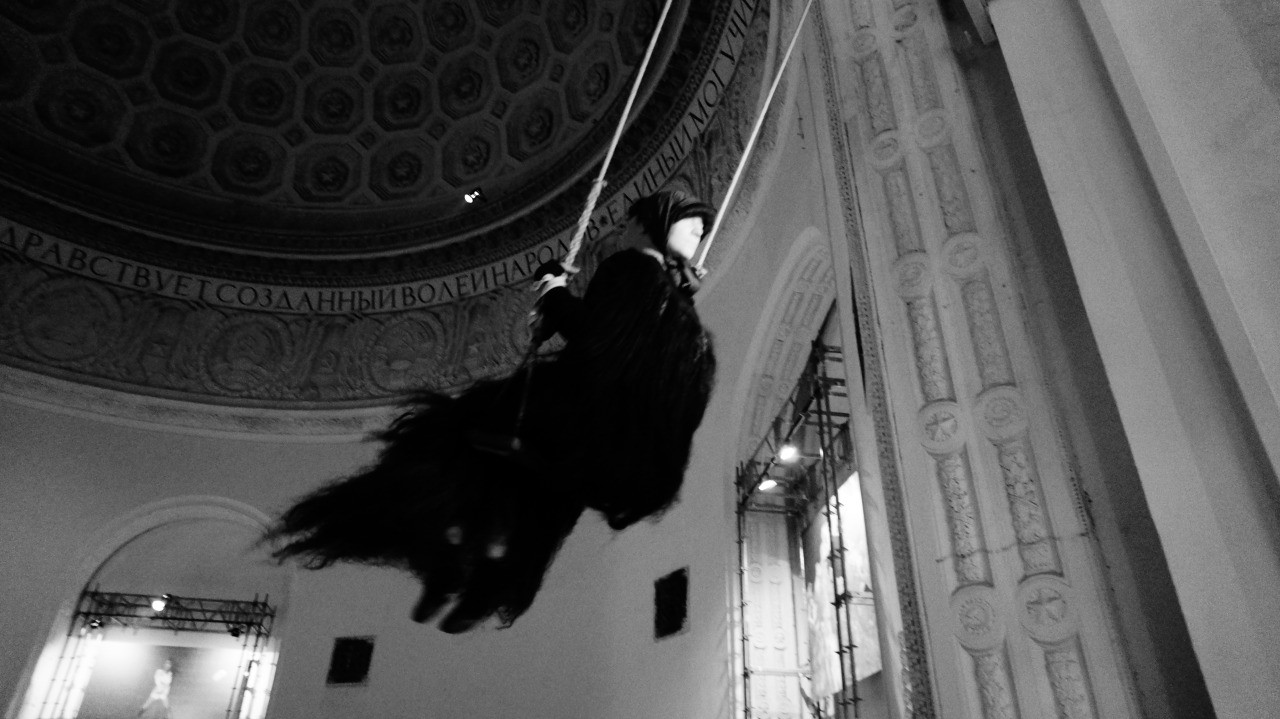Johanna van Overmeir is a Belgian artist who creates performance art, video and installations. Throughout the 6th Biennale Johanna will be swinging on a swing hung under a giant archway of the central pavilion.

Swinging is usually associated with careless childhood and outdoor fun. Swinging can make one feel a little nostalgic; it can make one feel sentimental and romantic. “The Winged Swing” is a recognizable symbol of the passing childhood and childish speculative fiction; a symbol memorialized in the popular soundtrack to the “The Adventures of the Elektronic” movie, known to every teenager who grew up in the late Soviet or post-Soviet era.
Swinging that can be observed at the Biennale will unlikely put anyone in a careless nostalgic mood. Instead it evokes a constant, unabated anxiety.
The wooden seat of the swing hangs two metres (six feet) high above the floor, which provides a large amplitude of movement. The artist is swinging furiously; she is wearing a dusty dress of black feathers, which makes it all look like an experiment with the demonic image of the black swan Odile from ‘The Swan Lake’ ballet. The sinister image is completed by the white mask worn by the artist on the back of her head. The constant movement of the figure who embodies the duplicity and menace creates an atmosphere of a permanent threat, circulating in the air above our heads. What is more, the artist is swinging without any safety wires, forced to cling to the swing ropes with her injured, bandaged hands.

According to the show’s concept, this artistic image addresses the topic of evident binary oppositions: Europe and Asia, past and future, light and darkness. But it would be more appropriate to interpret this spectacular act differently: as a permanent state of suspension, which does not create the feeling of freedom, but those of fear and despair, as well as the inevitable gag reflex that automatically comes with swinging. Nowadays this nausea a la Sartre is not limited to the state of abandonment and the co-occurring loneliness. Rather, it is a reaction to the general volatility, perplexity and precarity. This is social disorder, disorder of the mind, and inevitable disorder of digestion.
One would do well to remember that precarity is not a mere abstract situation characterised by the lack of security and wellbeing. It is a social effect engendered by the neoliberal economy and its serving superstructure. Just like in case of the artist herself who needs a special ladder and assistance to get down from the high swing, it would be a mistake to link precarity with a feeling of freedom. Precarity means absolute dependency on circumstances and someone else’s individual will. So all those who sympathize with the concepts of freedom that dominate in contemporary culture and mass media should ask themselves: would I want to take the artist’s place on that swing?
Text: Marina Simakova
.